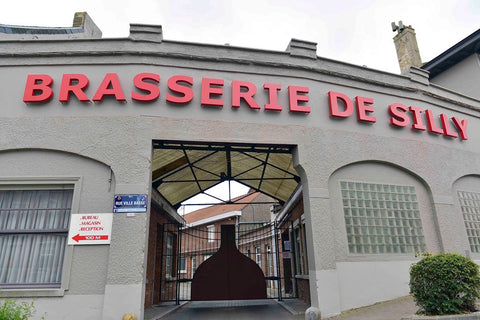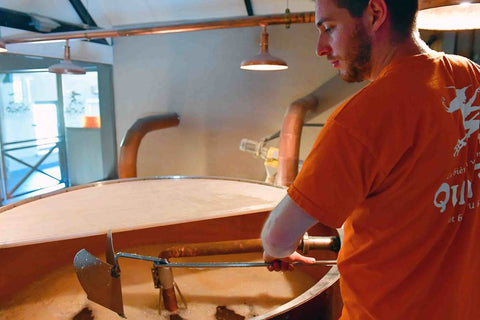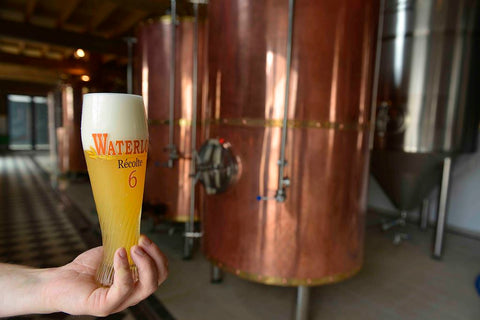- No products in the cart.
Brasserie de Rochefort

The Beginning – Like Chimay and Orval, fellow Ardennes Trappists, Rochefort owes much of its mystique to its setting. The abbey of Our Lady of Saint-Remy is an oasis of peace on the fringes of the modern world. There is little here to distract you from a rhythm of life consisting of manual work, prayer and sleep – exactly as preached by St. Benedict.
The library, the refectory, the reading room, the cloisters, even the brewery... everything here breathes simplicity and serenity. And nothing hinting at the abbey’s stormy past.
It all started peacefully enough, in 1230, with the establishment of Le Secours Notre-Dame. Rochefort's count, Gilles de Walcourt, and his wife, founded this convent one-and-a-half kilometres away from the town of Rochefort.
It wasn't until 1464 that Rochefort saw the arrival of Cistercian monks, as part of a religious order 'swap-over'. They gave up their abbey, Félipré near Givet, to the nuns, and proceeded to make Rochefort's abbey their home. Then came the marauding. The abbey was destroyed first by Protestant armies, in 1568. Then it was the turn of troops from Lorraine, who pillaged in 1650. The abbey was soon rebuilt, only for the church and abbey buildings to be demolished again, during the French Revolution.
In 1797, the remaining abbey properties were confiscated. It wasn't until 1887 that, once again, the monks re-erected their religious buildings.
But the new Trappist complex only officially reclaimed itself as an abbey in 1912. Through it all, though, the monks have done their best to keep the beer flowing. Archives indicate that brewing activity has taken place here since 1595. This brewing tradition, albeit only for the monks’ consumption, came to an abrupt end during the French Revolution. The French army occupied the region, and the abbey was plundered by the region’s inhabitants.
The rebuilt brewing hall was first taken back into use in 1899. Brother Zozime from Dongen (in the Netherlands) was the first of the new line of brewmasters. In later years, Father Dominique was to take brewing lessons at Leuven University, so that the notoriously volatile brewing quality could be brought under control.
Then war came-a-calling again – the First World War reached the abbey in 1918. The German occupiers removed the copper fittings from the brewing hall, and production was again halted for a while.
When, after the Second World War, Rochefort's beers declined from the success of Chimay's better known (and more consistent) brews, a little fraternal kindness was shown. The Chimay abbey’s Trappists decided to help their confrères improve the quality of their beer. Professor Jean Declerck from Leuven, who laid the basis for the current Chimay beers, together with his brother Théodore, advised the monks to change their production methods, impose micro-biological controls and pay more attention to hygiene.
So it was with Chimay’s assistance, that the Rochefort monks developed the current clutch of beer recipes. Brother Théodore of Chimay was responsible for selecting and isolating the initial yeast strains. However, this yeast was found not to ‘take’ very well in Rochefort, and so it was replaced by a variety sourced from the Palm brewery. In the 1950s the initial light 'refectory' beer was joined by the stronger Rochefort 8 and 10.
Success soon followed, and Rochefort has since carved out a strong niche in the heady Trappist market. But despite all the recent success and accolades, the story of Rochefort continues its twisting and turning.
The abbey recently made the news for all the wrong reasons – a fire broke out in 2010, which fortunately was extinguished quite quickly. But now the abbey is having to campaign for the preservation of the Tridaine spring – a water source integral to the abbey's famous brew.
It is threatened by excavations carried out by the owner of a nearby quarry. It's feared that these works may affect the course of the stream. The monks are worried this will have negative consequences on the quality of the water used to brew their much-praised beers.
The Brewing

It's something that's on the mind of Quality Manager, Santos Gumer. He points out the spring of the Tridaine, a kilometre away, in the hills above the abbey. This is the source of the hard water used for brewing at the abbey. The composition of the water turns out to be unique, and an important factor in the taste of the Rochefort beers. It even influenced the style of beer chosen by the abbey.
That's because Professor Declerck, Chimay's helping hand in the post-war period, advised Rochefort to only brew dark beers: the Tridaine's waters were best-suited to this style, he believed. This spring water, it turns out, is quite rich in calcium.
The recipe for today's Rochefort beers has been established since the 1960s. Minor tweaks are still made of course, depending on the season, and the quality of the ingredients supplied – or when new brewing equipment is taken into service.
But essentially the three Rochefort beers are brewed with the exactly the same ingredients: spring water, the Rochefort house yeast, special pale malts and caramel malts, aromatic and bitter hop varieties (pellets), white and brown sugar and a ‘secret herb’.
The only differences between them lies with the dosages used. The yeast used is actually retrieved from the Rochefort 6 and 8 brews, and used for both the main fermentation and re-fermentation.
The malts used include pilsner caramel, while Hallertau and Styrian Golding hops are used, primarily for aroma.
The brewing and main fermentation process takes one week. After bottling, the beer will re-ferment for fourteen days, in the 'warm rooms', at a temperature of 20 to 23°C.
The Brewers

Thierry Fourneau, plus Luc and Patrick Streignard, are now managing the brewery, with the assistance of Quality Manager Santos Gumer. Rochefort’s annual production is some thirty-five thousand hectolitres, which earns the brewery a place in the Trappist peloton – but not at the head. It is a deliberate choice not to be at the front of this particular, and rather peculiar, race.
Brother Pierre feels that the monks are working hard enough, without being under the additional stress of competitiveness. The Cistercian adage, it seems, applies equally well in the here-and-now as it did in the past.
Their main calling is the monkhood, with the brewery seen simply as a means for helping the abbey to support itself – as well as providing proceeds to go to charity.
A peaceful atmosphere is what the monks strive for most of all. Just to show what they mean by this, consider that the bottling plant is not actually operated at full capacity. If it did, the noise would interfere with prayers.
The Rochefort brewing hall is often described as ‘the most beautiful in Belgium’; it is looks like something akin to a ‘beer cathedral’, thanks to its peculiar dimensions (eight by thirty metres) and its tall, narrow leaded windows.
This handsome hall, with its copper boiling and filtering kettles, was last kitted out in 1960. A particularly remarkable feature is that the interior of the kettles is also made out of copper.
Most breweries nowadays use stainless steel kettles, even if the outside is made out of copper to please the eye. Rochefort remains traditional to its core.
The Beers
The Visit

Despite all that visual glory and heritage, the abbey and its brewery are sadly not open to the public. There is also no on-site cafe or tavern where you can taste these famous beers, or have lunch. However, the town of Rochefort offers plenty of opportunity to do so. A number of local restaurants and cafés have the Rochefort beers on their menu.
The town of Rochefort sits in the splendid surroundings of the Famenne, a region of low foothills building up to the Ardennes. Although many tourists head straight for the misty hills of the Ardennes, it is worth stopping off in the Famenne.
It's a landscape characterised by ragged woodland and gently undulating meadows. And if you want to locate the source of Rochefort's water, after some sleuthing you should be able to stand at the source of the Tridaine.
The spring is found on the hillside, some 40m higher than the abbey. In close proximity you will see the remains of a quarry, where red marble was once excavated. This stone was used in the construction of the Church of Saint-Loup in Namur.
If you want to extend your stay in the area, you can easily find a hotel or camping site in this tourist region. And the reason to linger a little longer? Some undiscovered brewery gems. One not widely known is that of Eprave, near Rochefort, which is home to a microbrewery. Brasserie de la Lesse now occupies the buildings of the former Brasserie Rochefortoise. Sample their Cambrée, Chinette Blonde or Rouge-Croix.
The Location

The Famenne has much to offer history buffs. Alongside the road from Rochefort to Eprave you will come across Merovingian cemeteries, dating back to the 9th-century AD. This region was quite densely populated, even before the Middle Ages.
The Malagne archaeological park takes you back to these ancient times. This is where one of the largest Roman villas in Northern Gaul was excavated and it has been restored, in part. It is thought that the small town of Rochefort has been fortified since Roman times.
The ruins of the fortified castle now offer splendid views over Rochefort. A number of archaeological finds are on display in the museum. The Lhomme, a tributary of the Lesse River, has sculpted the impressive ‘de la Lorette’ cave system.
To get to La Lorette, take the quaint tram from the centre of Han-sur-Lesse, which will wend its way right to the cave entrance. It's well worth taking the short trip. You will see some quite astonishing grottoes, with impressive names like the Minaret, the Mystérieuses, and the Salle d'Armes (complete with its newly installed backdrop of sound and light).
The immense Dôme (with a height of 129m), is particularly grand. You can then take a boat to explore the subterranean river, until you finally see the light at the end of the tunnel.
During your descent you can admire glittering halls and galleries. The Lesse itself snakes through a landscape that is most picturesque, partly to its many long-flowing meanders. A tourist train can take you through the nature reserve of Lesse et Lhomme (250 hectares), where the many animals roam, part-wild.
Getting There & Around

Take the E411 (Brussels-Luxembourg motorway) or the E42 (main artery between Doornik and Namur) followed by the E411. Either way, you'll exit the E411 at junction 23, heading in the direction of Han-sur-Lesse and Rochefort. The train journey from Brussels to Jemelle takes 1 hour and 45 minutes. Jemelle is located 3km from Rochefort, and the 424 bus will complete the final leg to Rochefort.
Walkers will find much to their liking in the Famenne region, a green region famous for its caves and natural beauty. A detailed map is pretty much essential, though, to help you discover this area’s rich cultural and historic heritage.
You can choose from 27 listed pathways, in and around Rochefort itself, varying in length between 3 and 12 km. And there are a further 44 signposted circular walks, that'll take you right back to where-ever you started from.
Cyclists will enjoy the stretch (21.3 km) from Jemelle to Houyet, alongside the former 150 railway track. This is by far the best way to discover the many faces of the valley of the Lesse.
The trail takes in a number of bridges, across first the Lhomme, and then the Lesse. It also, intriguingly, provides three old rail tunnels to pedal through, including the 464m long Hour-Havenne tunnel. The Lessive – Ave-et-Auffe cycle track (12 km) is nice alternative, one that will take you through woodland, beautifully-restored houses and the Sanctuary of Gethsemane.
Gastronomy, Food & More Beer

Like many abbeys, it's not just the beer that Rochefort is famed for – cheese plays its part too. Unlike the beer, though, the Rochefort cheese is produced outside the abbey walls, in a separate workshop. This sports the latest high-tech equipment, and is found in a nearby business park.
While the monks are behind the cheese's recipe, which was revived in 1999, the cheese-making these days is done by Beurrerie Mathot-SOFRA, one of Belgium's biggest buttery-and-cheese company. The cheeses are young, semi-mature and many-flavoured. The virgin taste of this semi-hard cheese has a pleasant, slightly sour flavour.
But there are also more complex flavours to hand. Varieties available include those containing seaweed, hazelnuts and Trappist beer – the obligatory glass of Rochefort, naturally, has to makes an appearance. The Trappist cheese is steeped in the beer for seven days so that the taste permeates right through to the centre.
The cheese is also steeped in a saline solution that contains a very specific lactic acid bacteria ('morge), a process that helps form the characteristic Rochefort colour and taste. The cheese remains submerged for between one and three months, and during this time the cheesemaker will turn the cheese over every two days.
Maturation ('affinage') is done at a constant temperature and humidity in the cellars, where the specific lactic acid bacteria are thriving. It is there that the typically rich taste fully develops, the texture also improving, with the cheese becoming supple and creamy inside, while a crust forms outside. This crust is then rinsed in a saline solution, so as to keeps its suppleness, and it assumes a golden yellow to red-brown colour.
Outside of the abbey-influenced gourmet delights, there's plenty else to excite the palate. Here in the Rochefort region, the ‘terroir’ tends to take on an Ardennes flavour, with pork, venison, wild boar and hare. Venison is often roasted on the bone, in the oven, using Ardennes butter from Rochefort. The recipe isn't complete without forest funghi, such as ceps, chanterelles or hedgehog mushrooms.
Fish lovers will find local pike-perch, or North Sea cod, depending on seasonal supply. And you can't keep the beer away from the food here in Rochefort. Good tips to try include chicken fillet in a Rochefort Trappist sauce; veal kidneys prepared with Rochefort; a sabayon with Trappist or Ardennes pâtés; and sausages, also with Trappist beer.
More Info
Tourist information for Rochefort:
VVV Rochefort
Rue de Behogne 5
B-5580 Rochefort
Tel: +32 (0)84/34 51 72
Web: www.valdelesse.be
Contact

L’Abbaye Notre Dame de Saint-Remy
rue de l’Abbaye 8
B-5580 Rochefort
rue de l’Abbaye 8
B-5580 Rochefort






